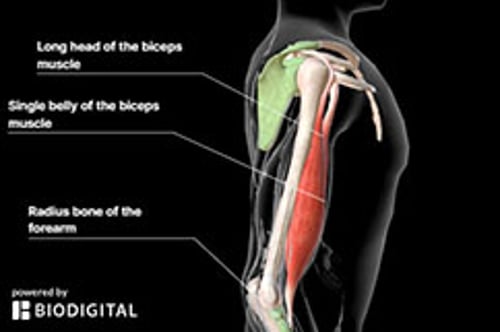Tears may occur in the tendons that attach the biceps muscle to the bones of the shoulder or the tendon that attaches the biceps muscle to one of the lower arm bones (at the elbow).
Topic Resources
(See also Overview of Sprains and Other Soft-Tissue Injuries.)
The biceps muscle has two tendons that attach to the shoulder blade (scapula) at the shoulder joint and one tendon that attaches to one of the arm bones (radius) at the elbow. The biceps tendons at the shoulder are more likely to be torn than the one at the elbow.
Biceps tendon tears are caused by a sudden forceful event (such as lifting a heavy object) or forceful straightening or twisting of the elbow. These tears typically occur when the tendon is already weakened by overuse (as occurs during weightlifting). Overuse can cause the tendon to become inflamed (called tendinitis) and sometimes frayed. In older people, the tendon may degenerate, increasing the risk of a tear. Other factors that can weaken a tendon may also increase risk.
The injury that tears the biceps tendons may also damage other structures in the shoulder, such as the rotator cuff.
The biceps tendon may be partially or completely torn. If a biceps tendon is completely torn, the tendon is completely detached from the bone. As a result, people usually cannot move their arm in certain directions. If only part of the tendon is torn, movement is unaffected, but the tendon may continue to tear and may later tear completely, particularly if people put substantial pressure on the arm.
Symptoms of Bicep Tendon Tears
Biceps tendon tears cause sudden, severe pain at the shoulder or near the elbow, depending on the location of the tear. Pain is worsened by lifting or pulling. Other symptoms include bruising, swelling, and weakness. The detached muscle may form a bulge in the arm (called Popeye deformity).
Diagnosis of Bicep Tendon Tears
A doctor's evaluation
Ultrasonography
Magnetic resonance imaging (MRI)
To diagnose biceps tendon tears, doctors ask detailed questions about the injury and do a thorough physical examination.
People should call or see a doctor if they have severe pain, range of motion at the shoulder or elbow is limited, or they have a bulge in their upper arm.
Ultrasonography of the shoulder is often also done. It can detect a complete tear of the tendons at the shoulder. Ultrasonography is less useful for partial tears and a tendon tear at the elbow.
MRI may be done to confirm the diagnosis but is usually not needed.
Treatment of Bicep Tendon Tears
Usually surgery
Biceps tendon tears at the elbow are usually repaired surgically as soon as possible.
However, general measures may be all that are needed to treat biceps tendon tears at the shoulder if one of the two tendons there is intact. Ice can minimize swelling and pain. Ice is enclosed in a plastic bag, towel, or cloth and applied for 15 to 20 minutes at a time, as often as possible during the first 24 to 48 hours. Nonsteroidal anti-inflammatory drugs (NSAIDs), such as ibuprofen, may also be used to reduce pain and inflammation. However, for some patients, NSAIDS may NOT be indicated because they can worsen bleeding and kidney function. Resting the injured arm using a sling prevents further injury and may speed healing.However, general measures may be all that are needed to treat biceps tendon tears at the shoulder if one of the two tendons there is intact. Ice can minimize swelling and pain. Ice is enclosed in a plastic bag, towel, or cloth and applied for 15 to 20 minutes at a time, as often as possible during the first 24 to 48 hours. Nonsteroidal anti-inflammatory drugs (NSAIDs), such as ibuprofen, may also be used to reduce pain and inflammation. However, for some patients, NSAIDS may NOT be indicated because they can worsen bleeding and kidney function. Resting the injured arm using a sling prevents further injury and may speed healing.
However, surgery is often needed to repair tendon tears at the shoulder, especially when other structures in the shoulder, such as the rotator cuff, are also damaged. If doctors suspect that biceps or rotator cuff tendons are torn, they refer the person to an orthopedic surgeon.


